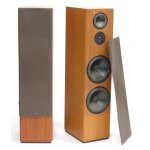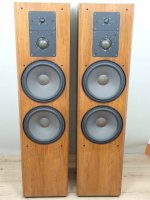Assume we have a pair of floor-standing speakers with dual woofers in closed enclosures format, as shown on attached. Replacing one woofer with a passive radiator will give trade-offs in what aspects?
As far as I can think, it may trade some SPL on woofer’s operating range, maybe about 3dB if the dual woofers are connected in parallel to each other, with a deep bass extension. And, of course, it requires to switch the woofers from dual 8 Ohms to a single 4 Ohms first.
What else can you think of it, please?
As far as I can think, it may trade some SPL on woofer’s operating range, maybe about 3dB if the dual woofers are connected in parallel to each other, with a deep bass extension. And, of course, it requires to switch the woofers from dual 8 Ohms to a single 4 Ohms first.
What else can you think of it, please?
Attachments
Last edited:
There are multiple completely different things here, so as-is, it doesn't make much sense. In no particular order:
- PBRs / ABRs are generally used as an alternative to a conventional ducted vent -usually in situations where a regular duct is impractical due to size or performance conditions
- Dropping a PBR into an existing sealed box alignment will change the alignment. How will depend on the volume, the bass driver LF characteristics, and the PBR characteristics
- Replacing a woofer with a PBR will reduce power-handling, likely reduce sensitivity & also efficiency (not the same things), and foul up the crossover as well, since you've immediately altered the impedance characteristics & likely the sensitivity characteristics the filter was designed for. It's not a given that there is a different impedance version of the same driver available, and if it is, it's also not a given that the sensitivity and response will be exact mirrors of the other unit, just at different levels (if relevant depending on how they were wired).

